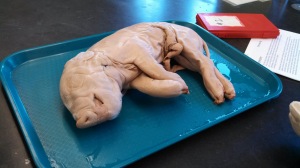WARNING: pictures contain a dead pig and its heart- maybe too gruesome
Dissecting a fetal pig was an interesting experience. This was the first time I was involved in the dissection of a pig and we were excited so we named the pig Phil. I was the person who wrote down answers for the lab report so I did not do any of the cutting up and pulling stuff out. Nonetheless, I was still really grossed out.
The smell bothered me and just looking at the pig, which I thought would be such a cute live piglet, made me feel squeamish. I was not expecting this because I thought that I was strong and stuff like this would not bother me, but it did so I kept my distance. That did not stop me from learning though. Throughout the entire dissection process it was necessary to remember that the pig was a fetal pig so its parts were not as developed as an adult. Also the pig had paint with pink for the arteries and blue for the veins. This makes sense, at least to me, because I think of it like the good blood (which contains oxygen in it) is pink and the bad blood (which does not contain oxygen) is blue.
In my head oxygen means good. I always thought it would be impossible to dissect something and figure out what each of the parts are, but it was actually quite clear- maybe even more than paper diagrams. Fetal pigs have similar structures to humans and human fetuses so they were good to study. It was nice when we couldn’t see something well in our pig like the spleen or something we had the pigs of other groups to get a clearer picture of what the organ looks like. Also our pig was the only girl pig, so it was the only one with a female reproductive system in our class. In order to see how the male reproductive system looked we needed to borrow pigs from class mates. Also something I noticed was that our pig was pinker and smelled less bad than the other pigs. At first I thought it was because it was a girl but after talking with my teacher I think it might be because of how old the body is.
 Anyway it was interesting to see how pigs differed from each other. I already had a good idea of the organs and have dissected frogs before, but what was special about dissecting a pig fetus was how similar it is to human fetuses. At one point the topic was brought up about fetuses pooping. Which was interesting because I was wondering where would the poop go since it’s inside the mom, but they don’t poop (if they do, it’s not good). This made sense to me because they don’t really have much to eat. Anyway I also thought it was interesting how the fetus does not use its lungs because the mother does the breathing for the fetus. These were all things I learned and found interesting about the pig dissection experience. This experience really helped learn about the insides of bodies and clear up some doubts I’ve always had.
Anyway it was interesting to see how pigs differed from each other. I already had a good idea of the organs and have dissected frogs before, but what was special about dissecting a pig fetus was how similar it is to human fetuses. At one point the topic was brought up about fetuses pooping. Which was interesting because I was wondering where would the poop go since it’s inside the mom, but they don’t poop (if they do, it’s not good). This made sense to me because they don’t really have much to eat. Anyway I also thought it was interesting how the fetus does not use its lungs because the mother does the breathing for the fetus. These were all things I learned and found interesting about the pig dissection experience. This experience really helped learn about the insides of bodies and clear up some doubts I’ve always had.
Click on the following to find out:

Hannah, I know that dissection can be an intense experience. I am proud of the way you handled the situation, focused on the learning, and shared your experience so clearly through this post. Nice work!
This experiment was really interesting. I did not realize it was a fetal pig until the blog said so and was really impressed that the students were able to dissect him. Naming the pig Phil was cute but also probably made it harder for every one to dissect him. I do not think we have the right to dissect pigs unless it is for the sole purpose of scientific learning.
I liked how you included the questions that came up for you during the experiment—including the gender, the smell, and how the excretion worked in a fetus- It was definitely interesting to note the details and differences between this and a full grown pig. I also like that you thought about the ethical question.
Poor Phil the Pig. Why did you name the pig? Didn’t that make it harder to dissect the pig. I was surprised about how similar pigs are to humans too. You would think that we are so very different, but we are more alike then we think. I don’t know about the connection of bad blood = no oxygen but it still would help remember the colors for a test and in the future.